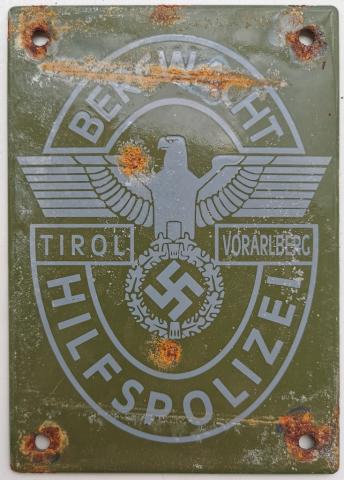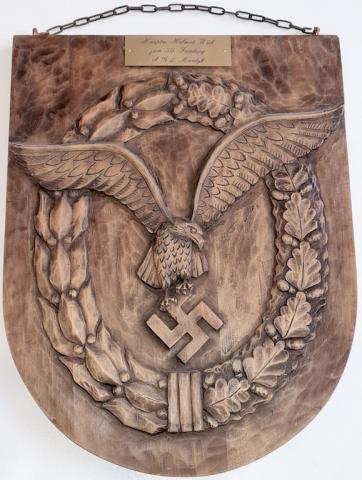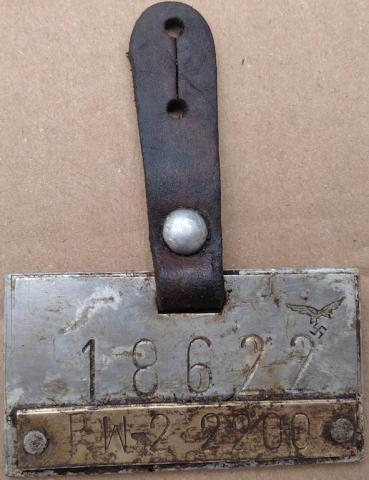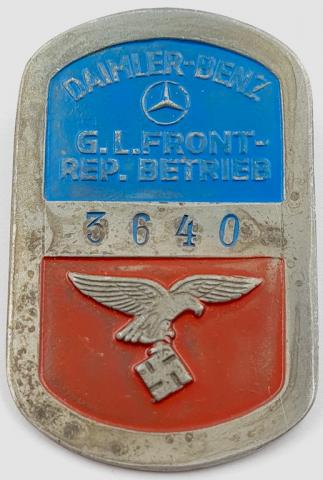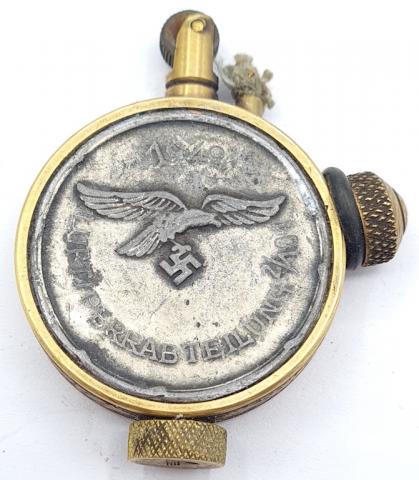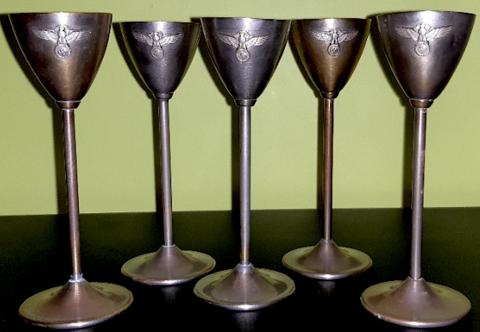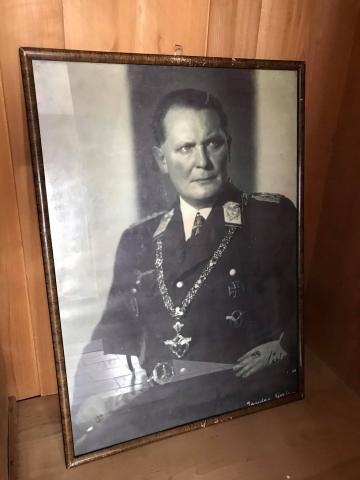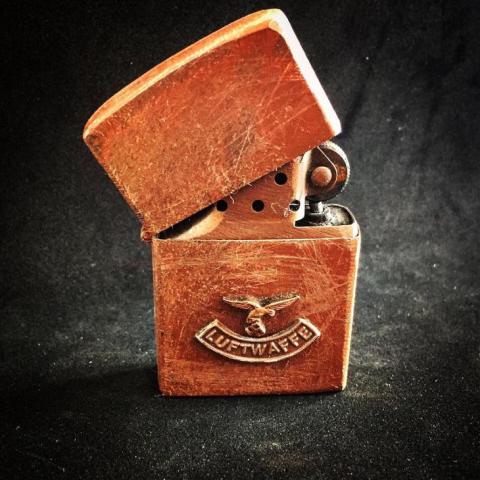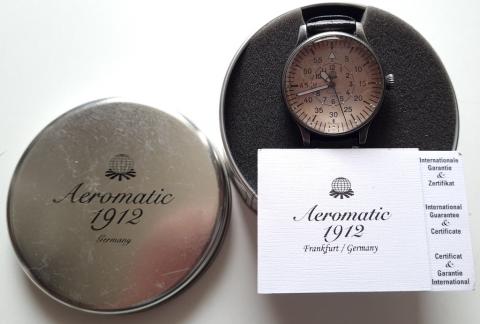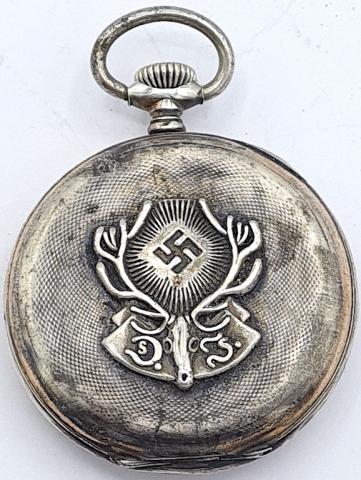WW2 GERMAN NAZI UNIQUE HELMUT WICK LUFTWAFFE PILOT CAPTAIN TROPHEE PLAQUE PLATE COMMEMORATIVE
Helmut Paul Emil Wick (5 August 1915 – 28 November 1940) was a German flying ace of World War II. He was a wing commander in the Luftwaffe (air force) of Nazi Germany, and the fourth recipient of the Knight's Cross of the Iron Cross with Oak Leaves, the nation's highest military decoration at the time.
Born in Mannheim, Wick joined the Luftwaffe in 1936 and was trained as a fighter pilot. He was assigned to Jagdgeschwader 2 "Richthofen" (JG 2—2nd Fighter Wing), and saw combat in the Battles of France and Britain. In October 1940, he was given the position of wing commander of JG 2—the youngest in the Luftwaffe to hold this position. Wick was shot down in the vicinity of the Isle of Wight on 28 November 1940, most likely by the British ace John Dundas, who was himself shot down by Wick's wingman. Wick was posted as missing in action, presumed dead. By then he had been credited with the destruction of 56 enemy aircraft in aerial combat, making him the leading German ace at the time. Flying the Messerschmitt Bf 109, he claimed all of his victories against the Western Allies.
On 31 August 1939 Wick was given orders to transfer to "Jagdgeschwader Richthofen Nr. I". At the time there was no such unit; the intention was to send him to Jagdgeschwader 1 (JG 1−1st Fighter Wing), based in Döberitz, near Berlin. During World War I the "Richthofen Geschwader" name had been attached to the World War I era Jagdgeschwader 1. The "Richthofen" name had been incorrectly put on Wick's order. Wick noticed the mistake, realizing that he could now choose between JG 1 or the famous Jagdgeschwader 2 (JG 2—2nd Fighter Wing) which currently bore the "Richthofen" name. He chose the Richthofen Geschwader, commanded by Oberst (Colonel) Gerd von Massow, the unit was equipped with the Bf 109 E-3 and used the tactical code Yellow 3.
Wick joined its 3. Staffel, serving in the air defence of Berlin during the German invasion of Poland which began World War II. Following the German victory in Poland, JG 2 was transferred to Frankfurt-Rebstock and tasked with protection of Germany's Western border during the Phoney War—the phase between Britain and France's declaration of war on Germany in September 1939, and the Battle of France in May 1940. Flying his sixth combat mission, Leutnant Wick claimed his first, and the Geschwader's second victory on 22 November 1939. Wick was interviewed by German press for a newsreel on his own "factual" account of the 22 November action. Near Nancy, he shot down a French Curtiss Hawk 75 fighter piloted by either Sergent Saillard or Camille Plubeau of the Groupe de Chasse II/4 Armée de l’Air, who were killed. For this feat, Wick received the Iron Cross 2nd Class (Eisernes Kreuz 2. Klasse). Wick was allowed to take home leave from his Geschwader and spent Christmas with his wife Ursel, his baby son Walter, and his parents, before returning to his Gruppe at Frankfurt-Rebstock. From 10 to 17 February 1940, Wick and six other members from JG 2 spent a week in the Black Forest on the Feldberg, skiing and relaxing.
On 10 May 1940, German forces launched an offensive in Western Europe, but Wick remained on the ground while his aircraft, Bf 109 Yellow 2, underwent an engine change. Seven days later, he was back in the air, recording three victories over French LeO 45 bombers in one mission. By 6 June, Wick had 10 confirmed and two unconfirmed victories, including four French Bloch 151/152 fighters that he shot down on 5 June to record his fourth through seventh victories. The two unconfirmed victories were Royal Navy Fairey Swordfish biplane torpedo bombers claimed on 19 May and for which he had no witnesses. Wick claimed that he observed one of the enemy gunners in the Swordfish wave a cloth which he perceived as an act of surrender before following it down and watching the pilot land. As he did so, the gunner apparently believed Wick was preparing to attack and fired forcing the German pilot to shoot it down. Wick reported it hit the ground and turned over near Calais. The action of 5 June, according to Wick, occurred near Péronne from 17:17 to 17:30. The French Air Force made an effort to bomb the bridge heads on the Somme on the 5 June. 126 sorties were flown. The 18 and 19 GBA (Groupe de bombardement—Group of Bombardment) lost four Bréguet 693 near Péronne when they were attacked by German fighters while undertaking an attack on German tanks and lorries. A second operation was carried out without loss to French bomber forces, but the escorting French fighter group GC I/4 lost one Curtis Hawk fighter. The French fighter commands, ZOAN and ZOAE flew 438 combat missions submitting the loss of 15 fighters. At approximately 17:00, three Morane-Saulnier M.S.406s from GC I/2 and five from II/2 were ordered to attack German spearheads. Near Roye, Somme, they were intercepted by 10 Bf 109s. Each side lost two aircraft. At the same time Dewoitine D.520 from GC II/7 lost four in combat with Bf 109s over the Somme sector, although the fighters they were attacked by were probably from II./JG 53.
